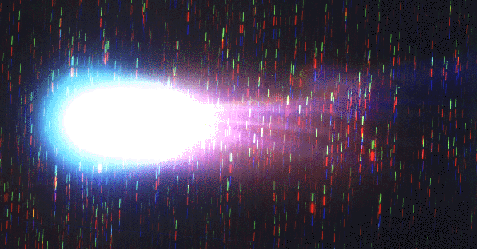Credit & Copyright: Anglo-Australian Observatory
Explanation:
The colors of
Comet Hyakutake are caused by the action of sunlight on
the dust and gas produced by the warming nucleus.
The microscopic dust particles
reflect sunlight while
the sun's ultraviolet radiation excites and ionizes
the gas molecules causing them
to glow or fluoresce in a range of visible colors.
This enhanced color picture
reveals subtle
color changes across the cometary coma and a faint multicolored tail.
It was made on the night of March 18-19 by combining separate
green, red, and blue photographs, each about a 15 minute exposure.
Some of the color features in the tail
may well represent real changes in its structure from one exposure
to the next.
The colored star trails,
created as the
Anglo-Australian Observatory's
UK Schmidt Telescope tracked the rapidly moving comet,
indicate the order of the separate exposures.
The cometary hues revealed here can not be seen directly due to
the human eye's lack of
color vision at the low light levels involved.
Latest Comet Hyakutake images:
JPL,
Fayetteville
Observer-Times,
NASA's Night of
the Comet,
ICSTARS,
Crni Vrh Obs.,
Cent. Mich U.
1999 2000 2001 2002 2003 2004 2005 2006 2007 2008 2009 2010 2011 2012 2013 2014 2015 2016 2017 2018 2019 2020 2021 2022 2023 2024 2025 |
Январь Февраль Март Апрель Май Июнь Июль Август Сентябрь Октябрь Ноябрь Декабрь |
NASA Web Site Statements, Warnings, and Disclaimers
NASA Official: Jay Norris. Specific rights apply.
A service of: LHEA at NASA / GSFC
& Michigan Tech. U.
|
Публикации с ключевыми словами:
comet Hyakutake - кома - комета Хиякутаке - кометные хвосты
Публикации со словами: comet Hyakutake - кома - комета Хиякутаке - кометные хвосты | |
См. также:
Все публикации на ту же тему >> | |
